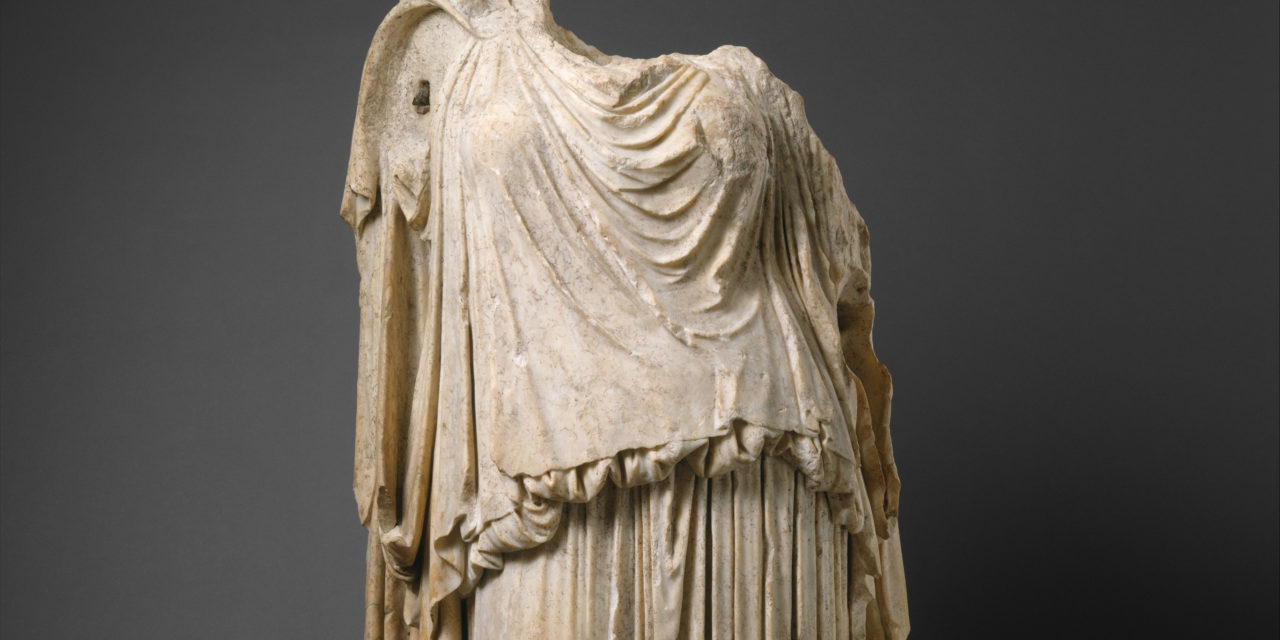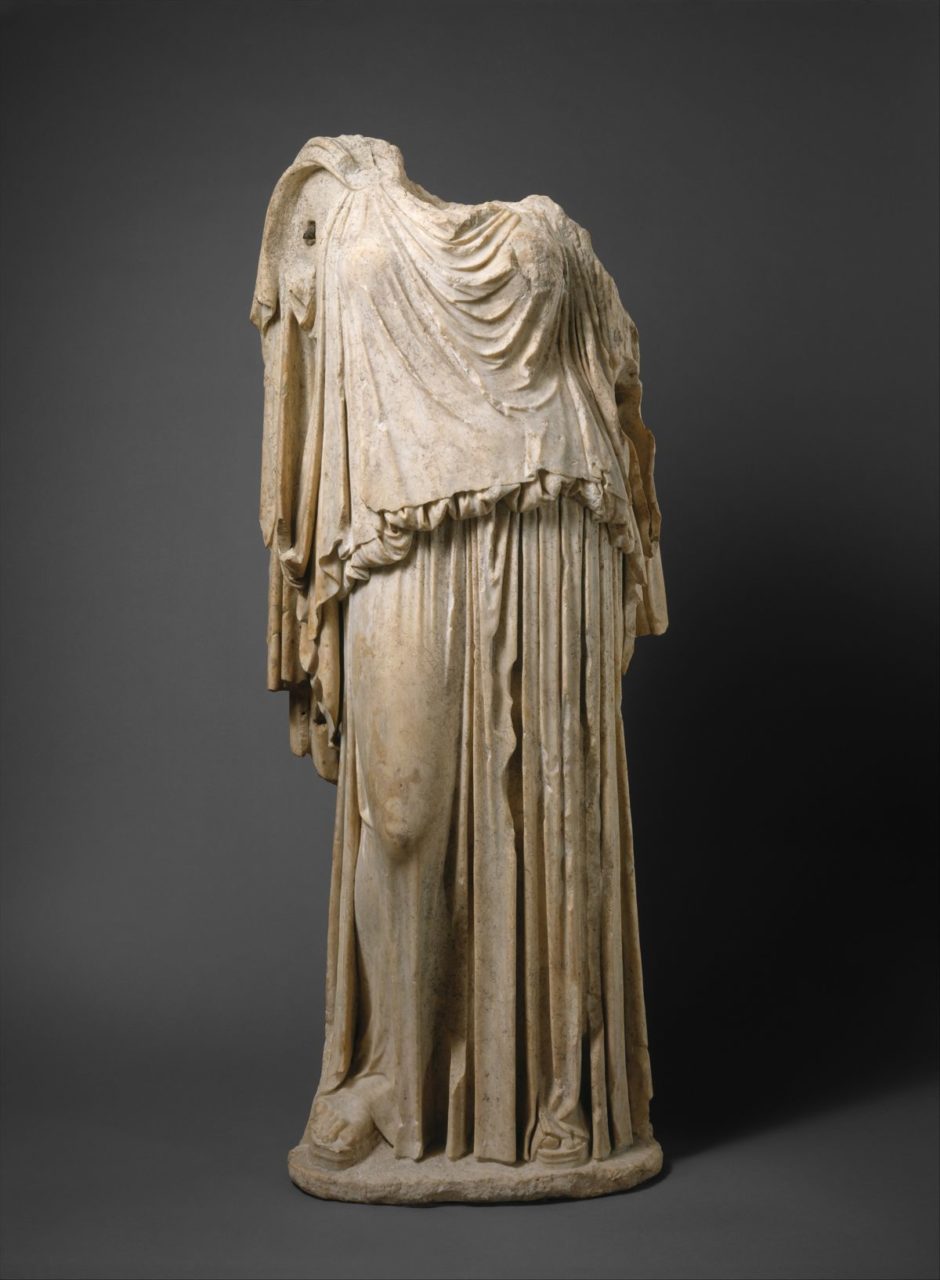A draped, outer garment made of a single piece of cloth that was worn by women in ancient Greece. Loose-fitting and held up with pins at the shoulder, its top edge was folded over to create a flap and it was often worn belted.
The Details
Sharon Sobel in Draping Period Costumes (2013) writes of the peplos that:
“The Doric Peplos is the most common woman’s garment seen in classical Greek art. Like the men’s garments of this period, it was made of one continuous piece of fabric woven to the desired size. The length was at least twice the women’s elbow-to-elbow measurement; the width was her neck-to-floor measurement plus enough extra to fold over at the top edge to form a flap.” (25)
In figure 1, the marble statues are displayed wearing peploses.
Sara Pendergast in Fashion, Costume, and Culture (2004) writes:
“The peplos was a simple sleeveless outer garment worn by the women of ancient Greece up to the early part of the sixth century B.C.E. Like many Greek garments, the peplos was formed from one large rectangle of woven fabric, which was folded and pinned in specific ways to become a gracefully draped tunic-like cloak.” (134)
The headless marble statue of Eirene in figure 2 is also represented wearing a peplos.
Valerie Cumming in The Dictionary of Fashion History (2010) defines the peplos as:
“A garment constructed from a long, rectangular section of linen or wool, later of cotton or silk. It was folded vertically then passed round the body, and distinguished from the chiton by an overfold of fabric over the bust and back, held by pins or brooches at the top of the shoulders, and belted at the waist or below the bust. Female peploi were ankle-length for the women unless depicted worn by goddesses or mythological characters, when they were knee-length. In an annual ritual a richly embroidered example was presented to the statue of Athena in Athens.”
Fig. 1 - Artist unknown (Greek, Attic). Statue, ca. 320 B.C. Marble, pentelic; h. of woman 144.5 cm h. of girl 103 cm (h. of woman 56 7/8 in h. of girl 40 9/16 in). New York: The Metropolitan Museum of Art, 44.11.2, .3. Rogers Fund, 1944. Source: The Met
Fig. 2 - Roman copy of Greek original by Kephisodotos (Roman, Early Imperial, Julio-Claudian). Marble statue of Eirene (the personification of peace), A.D. 14–68. Marble, pentelic; h. without plinth 177.2 cm (h. without plinth 69 3/4 in). New York: The Metropolitan Museum of Art, 06.311. Rogers Fund, 1906. Source: The Met
Its Afterlife
Fig. 3 - Paul Poiret (French, 1879–1944). Evening dress, 1922–23. Silk. New York: The Metropolitan Museum of Art, C.I.43.85.2a, b. Gift of Mrs. Muriel Draper, 1943. Source: The Met
Fig. 4 - Donna Karan (American, 1948-). Read to wear dress, Spring 2010. New York: Vogue, Model: Kasia Struss. Photographed by Marcio Madeira. Source: Vogue
References:
- Cumming, Valerie, C. W. Cunnington, and P. E. Cunnington. “Peplos.” In The Dictionary of Fashion History, 154. Oxford: Berg Publishers, 2010. Accessed April 26, 2019. https://www.bloomsburyfashioncentral.com/products/berg-fashion-library/dictionary/the-dictionary-of-fashion-history/peplos.
- “Peplos.” In The Ancient World, edited by Sara Pendergast and Tom Pendergast, 134-135. Vol. 1 of Fashion, Costume, and Culture: Clothing, Headwear, Body Decorations, and Footwear through the Ages. Detroit, MI: UXL, 2004. Gale Virtual Reference Library (accessed April 26, 2019). http://libproxy.fitsuny.edu:2540/apps/doc/CX3425500081/GVRL?u=fitsuny&sid=GVRL&xid=0b471d7a.
- Sobel, Sharon. Draping Period Costumes: Classical Greek to Victorian. The Focal Press Costume Topics Series. New York ; London: Focal Press, 2013. http://www.worldcat.org/oclc/940720233.














